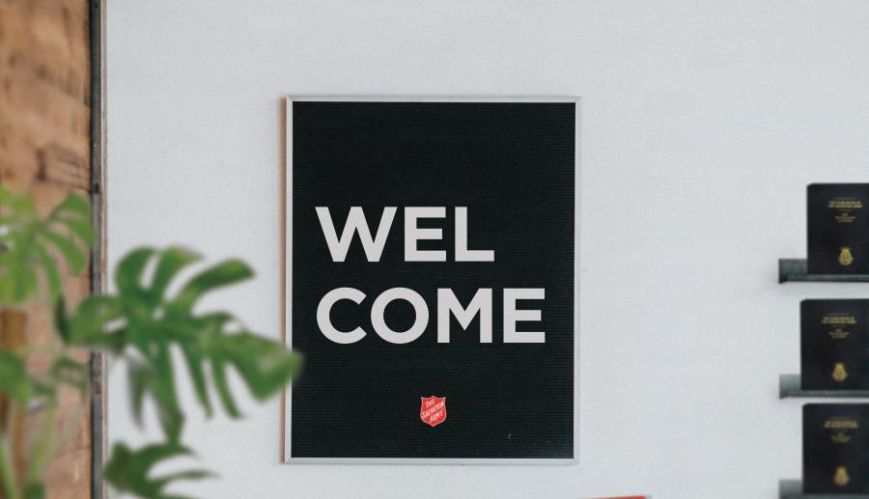Roll out the welcome mat!

Roll out the welcome mat!
8 February 2019
It’s important that we grapple with how we can better support, welcome, connect and integrate newcomers.
Research has shown and continues to show that church attendance in Australia is in decline. Perhaps now more than ever, we need to be grappling with what it means to meaningfully connect with those who walk through the doors of our churches.
Visitors to Salvation Army church services have often been connected through community engagement during the week. The latest Church Life Survey (2016) shows that 15 per cent of corps attendees are newcomers.
This is compared with the national average of only six per cent. One of the reasons for the Army’s high rate of newcomers is the requirement of Recovery Services (NSW, ACT and Queensland only) for participants to attend church services.
The research does, however, go on to indicate that The Salvation Army is perhaps the worst performer of all Christian churches in how it retains newcomers. In part, this can be attributed to the departure of Recovery Services participants after program completion. The statistics also suggest that the majority of newcomers do not make a meaningful connection and subsequently don’t return.
The greatest newcomer losses occur within the first year. The majority of the remaining cohort will stay no longer than five years after first attending/joining The Salvation Army. Regardless of whether someone is participating as part of a Recovery Services program, or visiting a church for another reason, it’s important that we grapple with how we can better support, welcome, connect and integrate newcomers.
In order to gain a better understanding of how The Salvation Army can begin to address the attrition, we have spoken with some corps who frequently experience and integrate newcomers.
This information has been distilled into a list of 10 of the most common traits and behaviours that these corps exhibit. In order to make this more than a merely academic exercise, some points contain a suggested action point.
The Salvation Army’s most welcoming corps:
1. Have a dedicated, passionate and committed welcoming team. The team is made up of individuals who are inherently inclusive and are able to make connections. Welcoming is valued as an important and integral contribution to the work of the church, not merely as a gap to be filled.
2. Identify and welcome each newcomer. Service hosts don’t draw attention to the newcomer in the meeting. They understand that not everyone who walks into a service wants to be known or seen. A welcoming corps is respectful of the individual’s journey. This is particularly of great importance when a corps has connection with a local Recovery Services expression. Special understanding of the joys and challenges of recovery is paramount to welcoming, connection and inclusion.
3. Do more than just point out the bathrooms. They are able to make people feel comfortable and at ease. This includes helping the visitor know about any children’s programs, morning tea or after-church lunches that may be running.
4. Ensure that their meetings are inclusive and are conducted in a way that is accessible to newcomers. This includes ensuring that any welcome and announcements are geared at making newcomers feel comfortable and aware of what’s going on. They don’t use lots of Salvation Army “lingo”, rather, they explain things in easily understood English. Action point: Develop materials that can be widely used in corps that explain The Salvation Army in everyday language. These materials are provided not just in English but other major community languages. .jpg&width=300&height=461)
5. Provide welcome packs. These packs include information not only about events in the life of the church but also information about the culture and vision of the church. Action point: Develop some basic welcome packs that can easily have local information added and changed. Ensure that there are multilingual options available.
6. Prioritise genuine friendships. They recognise that for someone to settle into their church takes considerable effort on both sides. They offer and pursue an intentional relationship regardless of whether someone is simply “checking it out” or actively in the process of making the corps their home church. They don’t give up on a relationship if the newcomer doesn’t speak English. They learn some words in the spoken language and show a commitment to connection.
7. Host well-organised, semi-regular gatherings for newcomers to gather and meet with some of the leadership of the church. These events are not held as an isolated event, but rather, augment the meaningful connections already made with newcomers. Action point: A visual presentation (video/graphic) created that can be used at these gatherings to better explain what it means to be a modern Salvation Army. The option of subtitles in major community languages to be included.
8. Acknowledge their weaknesses in inclusion and embark on developing understanding and making changes to ensure that they reflect the community they serve. Action point: To understand the potential for local mission delivery, corps could take the time to compare local data with their own understanding of the demographics of their worshipping community.
9. Are able to make strong connections with other Salvation Army expressions that are located in or near their worshipping community. They understand that integrated holistic mission requires collaboration and connection. Action point: Each corps to undertake a process to understand their present and potential local mission delivery. Resources like Asset Based Community Development provide an excellent starting point for discussion and reflection.
10. Acknowledge their limitations. They are able to express their needs for growth and improvement and actively seek input and inspiration.
Amanda Lennestal and Samantha Tan prepared this article while members of the Mission Support Team.